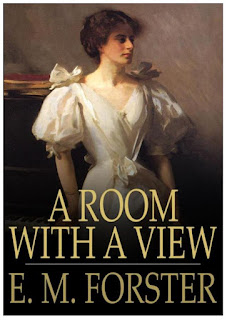A Room with a View
If you are old enough you will remember the 1985 film -- a huge success, with eight Academy Awards nominations, and so on, and Helen Bonham Carter in her breakthrough role. I'd like to see it again, especially now that I've finally got around to reading the book. There may be little point in writing about a novel published in 1908 with all the critical studies over the decades. However, reading the novel at the start of 2022 has left me with a few thoughts to share.
The first is the simple pleasure of reading this novel after some time among the serious (necessarily so) books of contemporary literary writers. I refer in particular to my last two entries: Don Delillo’s Zero K (2016) and Richard Flanagan’s The Living Sea of Waking Dreams (2020). E. M. Forster's A Room with a View operates very much like a two act romantic drama, with Act 1 set in Florence, and Act 2 set in Surrey (the setting is a house known as ‘Windy Corner’). A limited set of characters is introduced in Part 1 – Lucy Honeychurch, a young woman with a potentially independent spirit (to be decided); her emotionally stilted chaperone, Miss Charlotte Barlett; a contrasting pair of clergymen (the bubbly Beebe and the sanctimonious Eager); an awful Romantic novelist (Mrs Eleanor Lavish); and two up-an-coming yet looked-down-upon Londoners, George Emerson and his spirited father, Mr Emerson. In Part 2, we add Lucy’s family (brother, Freddy, and mother, Mrs Honeychurch) and a comically inadequate bookish fiance, Cecil. There’s a tennis match, a homoerotic frolic in the pond, proposals, stolen kisses, and a crisis for poor Lucy. While the novel’s two villains are literary types (Lavish and Cecil), the novel reminds us that fiction can entertain as its primary purpose, with themes of living life to its fullest and seeking out an independent view embedded beautifully within the living tale.
The second thought is that as an Edwardian novel, the
writing moves on from the Victorian realism to a psychological framing that
anticipates the modernist approach of writers like Virginia Woolf (To the Lighthouse and Mrs Dalloway). We aren’t quite there
yet, and no doubt there are many critical studies that make this point in detail; here is just one paragraph to demonstrate how Forster represents the
thoughts of Lucy, as memory coexists with the present in a moment of action:
Mr Floyd was her partner. She liked music, but how much
better tennis seemed. How much better to run about in comfortable clothes than
to sit at the piano and feel girt under the arms. George served, and surprised
her by his anxiety to win. He remembered how he had sighed among the tombs at
Santa Croce because things wouldn’t fit; how after the death of that obscure
Italian he had leant over the parapet by the Arno and said to her: ‘I shall
want to live, I tell you.’ He wanted to live now, to win at tennis, to stand
for all he was worth in the sun – in the sun which had begun to decline and was
shining in her eyes; and he did win (p.163).
While Mr Floyd isn’t important to Lucy, George Emerson is,
and here the reader is reminded of two of their three key moments together in
Florence (the third being the first kiss in a field of violets). The idea of
‘wanting to live’ is the potential Mr Beebe sees in her, and the sympathetic
reader hopes for -- to get away from the piano as sublimation for living a life
of passion, and just go ahead and live it. That dangerously democratic idea
that a man might be as worthy as his 'better' (‘all he was worth in the
sun’) is where the novel challenges the reader of the time – the trenches of
the first world war are only a matter of years away, and the fight for
independence for women is only just beginning. So, a light romance when
compared to contemporary apocalyptic fiction, but carrying some significant
messages about gender and social class, sexuality and desire, and a true religion
which sounds a lot like secular humanism. And much later, this two act drama packaged beautifully in a film to tinker the ivories, which is where most of us started.




Comments
Post a Comment